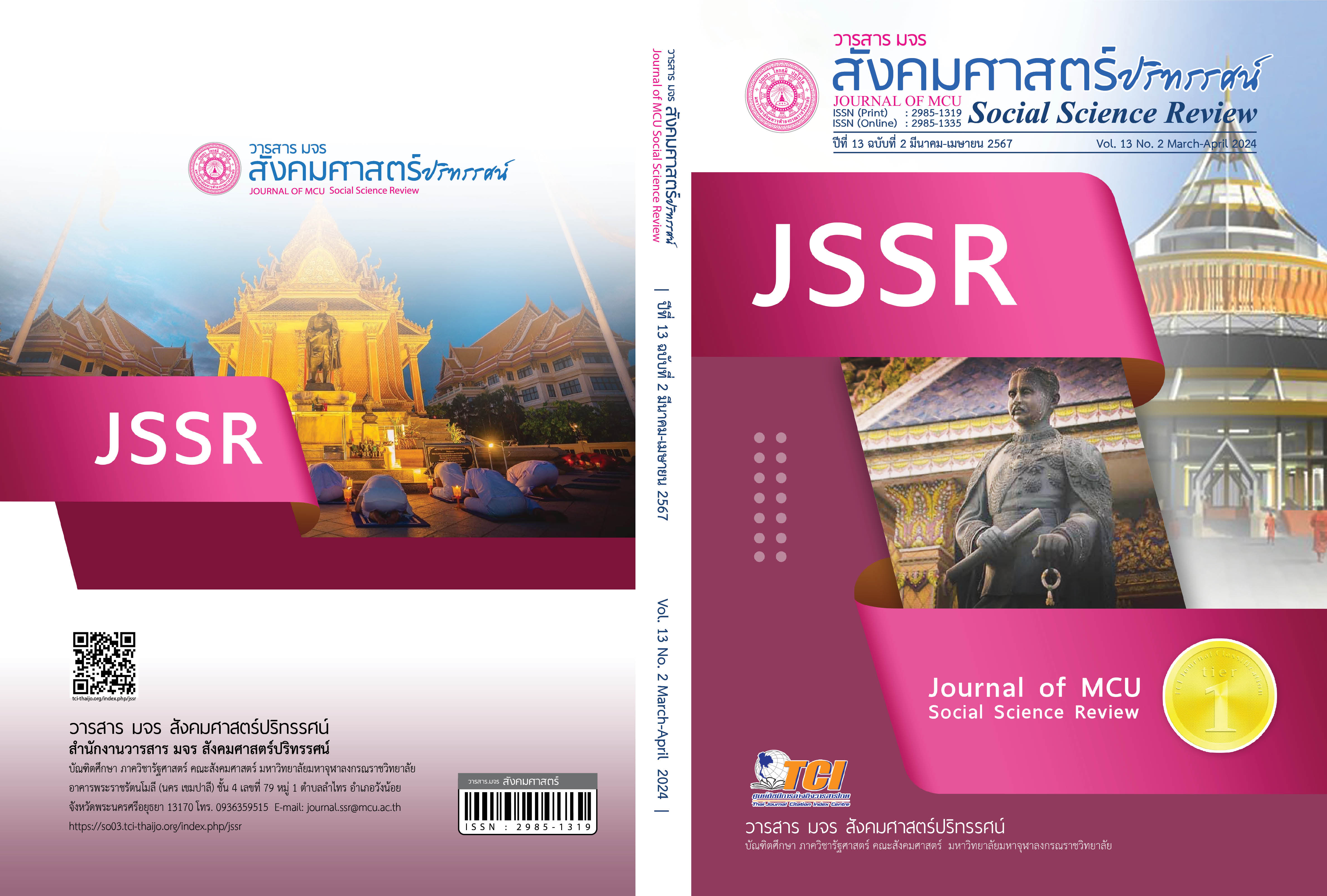เส้นทางความสำเร็จของผู้บริหารสตรีในโรงเรียนระดับมัธยมศึกษา สำนักงานเขตพื้นที่การศึกษามัธยมศึกษานนทบุรี
คำสำคัญ:
เส้นทางความสำเร็จ, ผู้บริหารสตรี, โรงเรียนมัธยมศึกษาบทคัดย่อ
บทความวิจัยนี้มีวัตถุประสงค์ 1. ศึกษาแรงบันดาลใจ แรงจูงใจ และเส้นทางการเข้าสู่ตำแหน่งผู้บริหารสถานศึกษาสตรีในโรงเรียนระดับมัธยมศึกษา 2. ศึกษาจุดแข็ง ข้อจำกัด โอกาส และความท้าทายของการเป็นผู้อำนวยการสถานศึกษาสตรีในโรงเรียนระดับมัธยมศึกษา สำนักงานเขตพื้นที่การศึกษามัธยมศึกษานนทบุรี เป็นการวิจัยเชิงคุณภาพ มีวัตถุประสงค์เพื่อศึกษาแรงบันดาลใจ แรงจูงใจ และเส้นทางการเข้าสู่ตำแหน่งผู้บริหารสถานศึกษาของสตรี และศึกษาจุดแข็ง ข้อจำกัด โอกาส และความท้าทายของการเป็นผู้อำนวยการสถานศึกษาสตรี ผู้ให้ข้อมูล ได้แก่ ผู้อำนวยการสถานศึกษาสตรี จำนวน 6 คน ด้วยวิธีการเลือกตัวอย่างแบบเจาะจง เก็บรวบรวมข้อมูลโดยใช้แบบสัมภาษณ์เชิงลึก
ผลการวิจัยพบว่า 1. ผู้บริหารสตรีมีแรงบันดาลใจในการเข้าสู่ตำแหน่งผู้บริหารสถานศึกษาจากการตั้งเป้าหมายของตนเอง โดยมีแรงจูงใจ 2 ประการ คือ 1) แรงจูงใจภายในตนเอง และ 2) แรงจูงใจภายนอก โดยผู้บริหารสตรีมีวิธีการเตรียมตัวเพื่อเข้าสู่ตำแหน่งผู้บริหารสถานศึกษาทั้งหมด 4 ประการ คือ 1) การเตรียมความพร้อมของตนเอง 2) การปฏิบัติตามกฎหมาย 3) การเป็นแบบอย่างที่ดี และ 4) การสร้างเครือข่ายในการทำงาน 2. จุดแข็งของผู้อำนวยการสถานศึกษาสตรีคือความละเอียดรอบคอบ และความอ่อนโยน ข้อจำกัดของผู้อำนวยการสถานศึกษาสตรีคือลักษณะทางกายภาพและบทบาทหน้าที่ทางสังคมของผู้หญิง โอกาสในการเป็นผู้บริหารของสตรีเกิดจากการเปลี่ยนแปลงของสภาพสังคมในปัจจุบันที่ให้การยอมรับในบทบาทและหน้าที่ของสตรีมากขึ้น และการใช้วิธีการสอบคัดเลือกผู้บริหารสถานศึกษา และความท้าทายของการเป็นผู้อำนวยการสถานศึกษาสตรีมี 2 ประการ คือ 1) การได้รับการยอมรับของสตรี และ 2) การบริหารงานบุคคลภายในสถานศึกษาของผู้บริหารสตรี
เอกสารอ้างอิง
โครงการพัฒนาแห่งสหประชาชาติ. (2563). รายงานการศึกษา การทบทวนความก้าวหน้าของการบังคับใช้พระราชบัญญัติความเท่าเทียมระหว่างเพศ พ.ศ. 2558. สืบค้น 22 กุมภาพันธ์ 2564, จาก https://shorturl.asia/Ja1B8
เจตปรียา ขำเสถียร. (2559). การพัฒนาหลักสูตรฝึกอบรมสมรรถนะผู้บริหารสตรีในสถานศึกษาขั้นพื้นฐาน (ดุษฎีนิพนธ์การศึกษาดุษฎีบัณฑิต สาขาวิชาการบริหารการศึกษา). ชลบุรี: มหาวิทยาลัยบูรพา.
บวร ประพฤติดี และคณะ. (2520). สตรีไทย : บทบาทในการเป็นผู้บริหารทางการศึกษา. กรุงเทพฯ: มหาวิทยาลัยรามคำแหง.
ปนัดดา นวธนโชติ. (2561). รูปแบบการส่งเสริมการเข้าสู่ตำแหน่งบริหารของผู้บริหารสตรีในสถานศึกษาขั้นพื้นฐานระดับมัธยมศึกษา (ดุษฎีนิพนธ์การศึกษาดุษฎีบัณฑิต สาขาวิชาการบริหารการศึกษา). พะเยา: มหาวิทยาลัยพะเยา.
ปาริฉัตร ตู้ดำ. (2556). ปัจจัยที่ส่งผลต่อความก้าวหน้าในอาชีพของผู้บริหารสตรีในองค์กร ภาครัฐ: การทบทวนวรรณกรรม. วารสารนักบริหาร, 33(3), 25-32.
พจน์ ใจชาญสุขกิจ. (2550). The Power of Inspiration. สืบค้น 29 ตุลาคม 2564, จาก https://shorturl.asia/NQ6HV
ราตรี ทองศรี. (2563). รูปแบบภาวะผู้นำของผู้บริหารสตรีในโรงเรียนประถมศึกษา (ดุษฎีนิพนธ์ปรัชญาดุษฎีบัณฑิต สาขาวิชาการบริหารการศึกษา). นครปฐม: มหาวิทยาลัยศิลปากร.
ราศรี สวอินทร์ และคณะ. (2562). การสร้างแรงบันดาลใจจากครูต้นแบบเพื่อพัฒนาตนเอง อย่างต่อเนื่องของนักศึกษาวิชาชีพครูในสามจังหวัดชายแดนใต้ (รายงานการวิจัย). ยะลา: มหาวิทยาลัยราชภัฏยะลา.
ฤทัยรัตน์ ดีภัย. (2563). การศึกษาภาวะผู้นำการเปลี่ยนแปลงของผู้บริหารสตรีส่งผลต่อการบริหารงานวิชาการในสถานศึกษาขั้นพื้นฐาน สังกัดสำนักงานเขตพื้นที่การศึกษาประถมศึกษาอุบลราชธานี เขต 1. วารสารบริหารการศึกษาบัวบัณฑิต, 20(4), 13-22.
วิลาวัลย์ ชูศรีวาส. (2562). พฤติกรรมการบริหารของผู้บริหารสตรีที่ส่งผลต่อประสิทธิผลของโรงเรียน สังกัดสำนักงานเขตพื้นที่การศึกษาประถมศึกษาจังหวัดกาฬสินธุ์. วารสาร มนุษยศาสตร์และสังคมศาสตร์ มหาวิทยาลัยนครพนม, 9(3), 44-52.
สำนักงานสภาพัฒนาการเศรษฐกิจและสังคมแห่งชาติ. (2564). ประเทศไทยกับการพัฒนาที่ยั่งยืน. สืบค้น 22 กุมภาพันธ์ 2564, จาก https://sdgs.nesdc.go.th/
อนันต์ชัย คงจันทร์. (2543). ปัจจัยที่มีอิทธิพลต่อความก้าวหน้าในอาชีพ ปัญหาและอุปสรรคในการทำงานของผู้บริหารสตรี. จุฬาลงกรณ์วารสาร, 13(49), 77-92.
เอกชัย บุญยาทิษฐาน. (2553). คู่มือวิเคราะห์ SWOT อย่างมืออาชีพ. กรุงเทพฯ: ปัญญาชน.
Alderfer, C. P. (1972). Existence Relatedness and Growth : Human Needs in Organization Settings. New York: Free Press.
Buasuwan, P. & Niyamajan, R. (2019) The Glass Ceiling Facing Women Leaders in Thai Higher Education. Retrieved May 3, 2022, from https://shorturl.asia/Nn8e1
Hurlock, E. B. (1978). Child Development (6th ed.). New York: McGraw-Hill.
Mochizuki, L. T. (2014). Key Factors Attributing to The Development of Successful Women Leaders in The Hawai’i Department of Education. Retrieved May 3, 2022, from http://hdl.handle.net/10125/100398
Perkins, K. (2011). A case study of women educational administrators and their perspectives on work and life roles. Retrieved May 3, 2022, from https://shorturl.asia/DwmfT
United Nations. (2021). Goals 5 Achieve gender equality and empower all women and girls. Retrieved February 22, 2022, from https://shorturl.asia/VMjow
ดาวน์โหลด
เผยแพร่แล้ว
รูปแบบการอ้างอิง
ฉบับ
ประเภทบทความ
สัญญาอนุญาต
ลิขสิทธิ์ (c) 2024 วารสาร มจร สังคมศาสตร์ปริทรรศน์

อนุญาตภายใต้เงื่อนไข Creative Commons Attribution-NonCommercial-NoDerivatives 4.0 International License.
เพื่อให้เป็นไปตามกฎหมายลิขสิทธิ์ ผู้นิพนธ์ทุกท่านต้องลงลายมือชื่อในแบบฟอร์มใบมอบลิขสิทธิ์บทความให้แก่วารสารฯ พร้อมกับบทความต้นฉบับที่ได้แก้ไขครั้งสุดท้าย นอกจากนี้ ผู้นิพนธ์ทุกท่านต้องยืนยันว่าบทความต้นฉบับที่ส่งมาตีพิมพ์นั้น ได้ส่งมาตีพิมพ์เฉพาะในวารสาร มจร สังคมศาสตร์ปริทรรศน์ เพียงแห่งเดียวเท่านั้น หากมีการใช้ภาพหรือตารางหรือเนื้อหาอื่นๆ ของผู้นิพนธ์อื่นที่ปรากฏในสิ่งตีพิมพ์อื่นมาแล้ว ผู้นิพนธ์ต้องขออนุญาตเจ้าของลิขสิทธิ์ก่อน พร้อมทั้งแสดงหนังสือที่ได้รับการยินยอมต่อบรรณาธิการ ก่อนที่บทความจะได้รับการตีพิมพ์ หากไม่เป็นไปตามข้อกำหนดเบื้องต้น ทางวารสารจะถอดบทความของท่านออกโดยไม่มีข้อยกเว้นใดๆ ทั้งสิ้น





